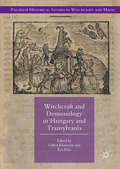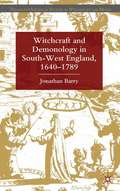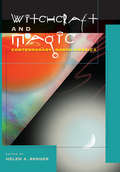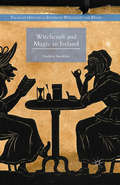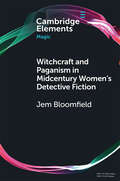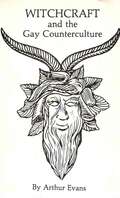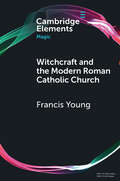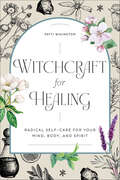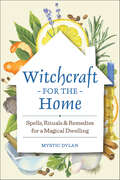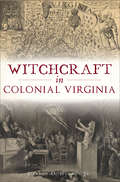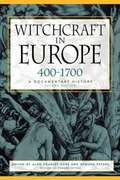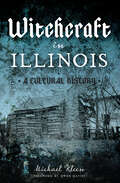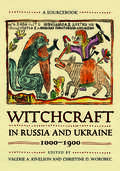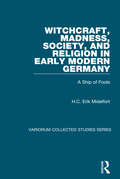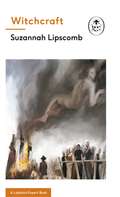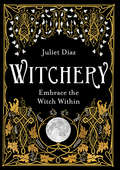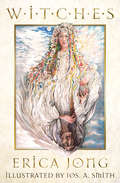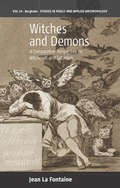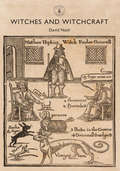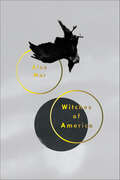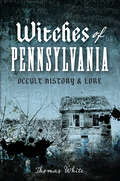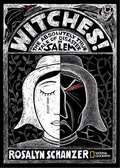- Table View
- List View
Witchcraft and Demonology in Hungary and Transylvania (Palgrave Historical Studies in Witchcraft and Magic)
by Gábor Klaniczay Éva PócsExamines urban and rural witchcraft conflicts from early modern times to the present.<P><P> Analyses the role of healers, midwives, and cunning folk in social, legal, medical and religious contexts.<P> Traces the decriminalisation of witchcraft and decline of persecution in Hungary and Transylvania.<P> This book provides a selection of studies on witchcraft and demonology by those involved in an interdisciplinary research group begun in Hungary thirty years ago. They examine urban and rural witchcraft conflicts from early modern times to the present, from a region hitherto rarely taken into consideration in witchcraft research. Special attention is given to healers, midwives, and cunning folk, including archaic sorcerer figures such as the táltos; whose ambivalent role is analysed in social, legal, medical and religious contexts. This volume examines how waves of persecution emerged and declined, and how witchcraft was decriminalised. Fascinating case-studies on vindictive witch-hunters, quarrelling neighbours, rivalling midwives, cunning shepherds, weather magician impostors, and exorcist Franciscan friars provide a colourful picture of Hungarian and Transylvanian folk beliefs and mythologies, as well as insights into historical and contemporary issues.
Witchcraft and Demonology in South-West England, 1640–1789
by Jonathan BarryInvestigating the continuing meaning of witchcraft and demonology in England in its period of supposed decline, Jonathan Barry takes six cases from south-western England between 1640 and 1789, and explores them in great depth to reveal the multiple and contested meanings of what occurred and how it was explained. Eschewing simple polarities of 'belief' or 'scepticism' about witches and the Devil, his studies here examine how our surviving evidence was created (and how carefully it must therefore be used) and transmitted down to our time. Barry's introduction and conclusion then bring out the wider implications, not only for the history of witchcraft and demonology, but for our understanding of the factors underlying cultural and intellectual change in England between the English and French revolutions, a time when political and religious pluralism and the impact of enlightenment ideas coexisted with deep-rooted commitment to a providentialist ideal of a united Protestant society, built on Biblical and legal traditions.
Witchcraft and Folk Belief in the Age of Enlightenment: Scotland, 1670-1740 (Palgrave Historical Studies in Witchcraft and Magic)
by Lizanne HendersonTaking an interdisciplinary perspective, Witchcraft and Folk Belief in the Age of Enlightenment represents the first in-depth investigation of Scottish witchcraft and witch belief post-1662, the period of supposed decline of such beliefs, an age which has been referred to as the 'long eighteenth century', coinciding with the Scottish Enlightenment. The late seventeenth and early eighteenth centuries were undoubtedly a period of transition and redefinition of what constituted the supernatural, at the interface between folk belief and the philosophies of the learned. For the latter the eradication of such beliefs equated with progress and civilization but for others, such as the devout, witch belief was a matter of faith, such that fear and dread of witches and their craft lasted well beyond the era of the major witch-hunts. This study seeks to illuminate the distinctiveness of the Scottish experience, to assess the impact of enlightenment thought upon witch belief, and to understand how these beliefs operated across all levels of Scottish society.
Witchcraft and Magic
by Helen A. BergerMagic, always part of the occult underground in North America, has experienced a resurgence since the 1960s. Although most contemporary magical religions have come from abroad, they have found fertile ground in which to develop in North America. Who are today's believers in Witchcraft and how do they worship? Alternative spiritual paths have increased the ranks of followers dramatically, particularly among well-educated middle-class individuals. Witchcraft and Magic conveys the richness of magical religious experiences found in today's culture, covering the continent of North America and the Caribbean.These original essays survey current and historical issues pertinent to religions that incorporate magical or occult beliefs and practices, and they examine contemporary responses to these religions. The relationship between Witchcraft and Neopaganism is explored, as is their intersection with established groups practicing goddess worship. Recent years have seen the growth in New Age magic and Afro-Caribbean religions, and these developments are also addressed in this volume.All the religions covered offer adherents an alternative worldview and rituals that are aimed at helping individuals redefine themselves and make their interactions with the environment more empowered. Many modern occult religions share an absence of dogma or central authority to determine orthodoxy, and have become a contemporary experience embracing modern concerns like feminism, environmentalism, civil rights, and gay rights. Afro-Caribbean religions such as Santería, Palo, and Curanderismo, which do have a more developed dogma and authority structure, offer their followers a religion steeped in African and Hispanic traditions. Responses to the growth of magical religions have varied, from acceptance to an unfounded concern about the growth of a satanic underground. And, as magical religions have flourished, increased interest has resulted in a growing commercialization, with its threat of trivialization.
Witchcraft and Magic in Ireland (Palgrave Historical Studies in Witchcraft and Magic)
by Andrew SneddonThis is the first academic overview of witchcraft and popular magic in Ireland and spans the medieval to the modern period. Based on a wide range of un-used and under-used primary source material, and taking account of denominational difference between Catholic and Protestant, it provides a detailed account of witchcraft trials and accusation.
Witchcraft and Paganism in Midcentury Women's Detective Fiction (Elements in Magic)
by Jem BloomfieldWitchcraft and paganism exert an insistent pressure from the margins of midcentury British detective fiction. This Element investigates the appearance of witchcraft and paganism in the novels of four of the most popular female detective authors of the era: Agatha Christie, Margery Allingham, Ngaio Marsh and Gladys Mitchell. The author approaches the theme of witchcraft and paganism not simply as a matter of content but as an influence which shapes the narrative and its possibilities. The 'witchy' detective novel, as the author calls it, brings together the conventions of Golden Age fiction with the images and enchantments of witchcraft and paganism to produce a hitherto unstudied mode of detective fiction in the midcentury.
Witchcraft and the Modern Roman Catholic Church (Elements in Magic)
by Francis YoungWitchcraft is rarely mentioned in official documents of the contemporary Roman Catholic church, but ideas about the dangers of witchcraft and other forms of occultism underpin the recent revival of interest in exorcism in the church. This Element examines hierarchical and clerical understandings of witchcraft within the contemporary Roman Catholic church. The Element considers the difficulties faced by clergy in parts of the developing world, where belief in witchcraft is so dominant it has the potential to undermine the church's doctrine and authority. The Element also considers the revival of interest in witchcraft and cursing among Catholic demonologists and exorcists in the developed world. The Element explores whether it is possible for a global church to adopt any kind of coherent approach to a phenomenon appraised so differently across different cultures that the church's responses to witchcraft in one context are likely to seem irrelevant in another.
Witchcraft for Healing: Radical Self-Care for Your Mind, Body, and Spirit
by Patti WigingtonHeal and grow with the restorative power of witchcraftWitchcraft is rooted in wellness and healing, and has the capacity to radically transform your life through self-care. Witchcraft for Healing will bring more spiritual, emotional, and physical healing to your practice.No other natural healing books weave in magic and self-care quite like Witchcraft for Healing.Explore the transformative power of the spells, potions, rituals, and remedies found in this essential witchcraft spell book. Discover new applications for ingredients and elements you can easily find or already have on hand such as candles, crystals, herbs, and essential oils.Whether you're new to witchcraft or are an experienced practitioner, you'll find ways to deepen your craft and reclaim your power through authentic information, practical applications, and empathetic wisdom.Soothe and support your mind, body, and spirit with Witchcraft for Healing.
Witchcraft for the Home: Spells, Rituals, & Remedies for a Magical Dwelling
by Mystic DylanConjure up a purified, protected, and balanced home with 60 enchanting spells and rituals We all have the power to work a little magic inside our homes. With practical spells, rituals, and remedies, this charming guide has everything you need to know about home witchcraft and how you can use it to manifest your desires.Magic for every purpose—Explore witchcraft recipes for everything from driving away negative spirits and attracting abundance, to energizing your workspace and bringing luck into any room.Call on your magical allies—Transform your home by invoking your ancestors and household spirits.Enhance your magic—Discover how to harness the power of the elements, lunar phases, astrology, and the seasons to heighten your home witchcraft.Transform your abode into a divine sanctuary with this standout among witchy books.
Witchcraft in Colonial Virginia
by Carson O. Hudson Jr.The Emmy Award–winning screenwriter &“examines spine-tingling tales in chapters called &‘The Beliefs,&’ &‘The Law,&’ &‘The Experts&’ and &‘The Witches&’&” (Bristol Herald Courier).While the Salem witch trials get the most notoriety, Virginia&’s witchcraft history dates back many years before that . . . Colonial Virginians shared a common belief in the supernatural with their northern neighbors. While the witchcraft mania that swept through Salem, Massachusetts, in 1692 was significant, fascination with it has tended to overshadow the historical records of other persecutions throughout early America. The 1626 case of Joan Wright, the first woman to be accused of witchcraft in British North America, began Virginia&’s own witch craze. Utilizing surviving records, author, local historian and screenwriter Carson Hudson narrates these fascinating stories.
Witchcraft in Europe, 400-1700: A Documentary History
by Alan Charles Kors Edward PetersSelected by Choice magazine as an Outstanding Academic Book for 2001 The highly-acclaimed first edition of this book chronicled the rise and fall of witchcraft in Europe between the twelfth and the end of the seventeenth centuries. Now greatly expanded, the classic anthology of contemporary texts reexamines the phenomenon of witchcraft, taking into account the remarkable scholarship since the book's publication almost thirty years ago. Spanning the period from 400 to 1700, the second edition of Witchcraft in Europe assembles nearly twice as many primary documents as the first, many newly translated, along with new illustrations that trace the development of witch-beliefs from late Mediterranean antiquity through the Enlightenment. Trial records, inquisitors' reports, eyewitness statements, and witches' confessions, along with striking contemporary illustrations depicting the career of the Devil and his works, testify to the hundreds of years of terror that enslaved an entire continent. Thomas Aquinas, Martin Luther, Thomas Hobbes, and other thinkers are quoted at length in order to determine the intellectual, perceptual, and legal processes by which "folklore" was transformed into systematic demonology and persecution. Together with explanatory notes, introductory essays--which have been revised to reflect current research--and a new bibliography, the documents gathered in Witchcraft in Europe vividly illumine the dark side of the European mind.
Witchcraft in Illinois: A Cultural History
by Michael KleenThe hidden history of witchcraft in the Land of Lincoln is revealed in this unique study by the author of Haunting Illinois. Although the Salem Witch Trials have drawn focus to New England as the center of witchcraft in American history, the practice was widespread across the Midwest. In Illinois, witchcraft—and witch persecution—have been part of local culture since French explorers arrived in the 17th century. In Witchcraft in Illinois, historian Michael Kleen presents the full story of the Prairie State's dalliance with the dark arts. On the Illinois frontier, pioneers pressed silver dimes into musket balls to ward off witches, while farmers dutifully erected fence posts according to phases of the moon. In 1904, the quiet town of Quincy was shocked to learn of Bessie Bement's suicide, after the young woman sought help from a witch doctor to break a hex. In turn-of-the-century Chicago, Lauron William de Laurence's occult publishing house churned out manuals for performing bizarre rituals intended to attract love and exact revenge.
Witchcraft in Russia and Ukraine, 1000–1900: A Sourcebook (NIU Series in Slavic, East European, and Eurasian Studies)
This sourcebook provides the first systematic overview of witchcraft laws and trials in Russia and Ukraine from medieval times to the late nineteenth century. Witchcraft in Russia and Ukraine weaves scholarly commentary with never-before-published primary source materials translated from Polish, Russian, and Ukrainian. These sources include the earliest references to witchcraft and sorcery, secular and religious laws regarding witchcraft and possession, full trial transcripts, and a wealth of magical spells. The documents present a rich panorama of daily life and reveal the extraordinary power of magical words.Editors Valerie A. Kivelson and Christine D. Worobec present new analyses of the workings and evolution of legal systems, the interplay and tensions between church and state, and the prosaic concerns of the women and men involved in witchcraft proceedings. The extended documentary commentaries also explore the shifting boundaries and fraught political relations between Russia and Ukraine.
Witchcraft, Demonology, and Confession in Early Modern France
by Virginia KrauseDenounced by neighbors and scrutinized by demonologists, the early modern French witch also confessed, self-identified as a witch and as the author of horrific deeds. What led her to this point? Despair, solitude, perhaps even physical pain, but most decisively, demonology's two-pronged prosecutorial and truth-seeking confessional apparatus. This book examines the systematic and well-oiled machinery that served to extract, interpret, and disseminate witches' confessions in early modern France. For the demonologist, confession was the only way to find out the truth about the clandestine activities of witches. For the witch, however, trial confessions opened new horizons of selfhood. In this book, Virginia Krause unravels the threads that wove together the demonologist's will to know and the witch's subjectivity. By examining textual and visual evidence, Krause shows how confession not only generated demonological theory but also brought forth a specific kind of self, which we now recognize as the modern subject.
Witchcraft, Madness, Society, and Religion in Early Modern Germany: A Ship of Fools (Variorum Collected Studies)
by H.C. Erik MidelfortH.C. Erik Midelfort has carved out a reputation for innovative work on early modern German history, with a particular focus on the social history of ideas and religion. This collection pulls together some of his best work on the related subjects of witchcraft, the history of madness and psychology, demonology, exorcism, and the social history of religious change in early modern Europe. Several of the pieces reprinted here constitute reviews of recent scholarly literature on their topics, while others offer sharp departures from conventional wisdom. A critique of Michel Foucault’s view of the history of madness proved both stimulating but irritating to Foucault’s most faithful readers, so it is reprinted here along with a short retrospective comment by the author. Another focus of this collection is the social history of the Holy Roman Empire, where towns, peasants, and noble families developed different perceptions of the Protestant and Catholic Reformations and of the options the religious revolutions of the sixteenth century offered. Finally, this collection also brings together articles which show how Freudian psychoanalysis and academic sociology have filtered and interpreted the history of early modern Germany.
Witchcraft: A Ladybird Expert Book (The Ladybird Expert Series #36)
by Suzannah LipscombPart of the new Ladybird Expert series, Witchcraft is a clear, simple and entertaining introduction to the magical myths that have coloured the popular imagination for centuries. Written by celebrated historian and broadcaster Dr Suzannah Lipscomb, Witchcraft explores the moment in history when witches were perceived to be especially dangerous: the famous witch hunts between 1450 and 1750.Written by the leading lights and most outstanding communicators in their fields, the Ladybird Expert books provide clear, accessible and authoritative introductions to subjects drawn from science, history and culture.For an adult readership, the Ladybird Expert series is produced in the same iconic small hardback format pioneered by the original Ladybirds. Each beautifully illustrated book features the first new illustrations produced in the original Ladybird style for nearly forty years.
Witchcraft: Theory and Practice
by Ly de AngelesAre you ready to open yourself to the divine powers in order to bring beauty into your life, happiness to your heart, and strength to your will? Then you'll want to get Witchcraft: Theory and Practice by Ly de Angeles. With more than three decades of experience she has learned how to bring the teachings alive, combining modern with ancient, so you can better understand the true potential and depth of Witchcraft.Within the pages of this book you will find the secrets and techniques to become a Witch. These can be divided into three categories: philosophical disciplines, spiritual beliefs, and practical techniques. Each part gets a focus in this book.In the first section, you will:Learn meditation and how it can be used for ritualDiscover the secrets of visualization, telepathy, and personal powerUse the self-analysis techniques to discover who you are and never walk in anyone's shadow In the second section you can:Uncover the essence of the God and GoddessDiscover the festivals of WitchcraftLearn how to make and use the tools of WitchcraftUnderstand how to do rituals, including the rite of self-initiation And in the final section, you'll:Practice psychic protection, shapeshifting, and banishingMaster astral projectionLearn to interpret omensThis really just barely covers some of the information you will find revealed in these pages. Written in a style that is clear and concise, this book will add to your knowledge of Witchcraft. Whether you are new to the Craft or have been practicing for some time, Witchcraft: Theory and Practice will impart wisdom that will fascinate and entice. You will be using this book for many years to come.
Witchery: Embrace the Witch Within
by Juliet DiazEverywhere, the witches are rising. Are you ready to answer the call and embrace your own inner witch?In this book, third-generation Witch Juliet Diaz guides you on a journey to connect with the Magick within you. She explains how to cast off what doesn't serve you, unleash your authentic self, and become an embodiment of your truth. You'll also learn the skills and techniques you need to build your own Magickal craft. Within these enchanted pages you'll discover how to: * Connect with the power of your inner witch * Create spells, potions, and rituals for love, protection, healing, manifestation and more * Amplify your energy by working with a Book of Shadows * Create an altar and decorate it according to the seasons * Work with the Moon and the Seasons of the Witch * Connect with your ancestors to receive their wisdomFilled with Magick, inspiration, and love, Witchery is your guide and companion on a wickedly delicious journey to true self-empowerment.
Witches (Abradale Bks.)
by Erica JongThe New York Times–bestselling author of Fear of Flying celebrates witches in a gorgeously illustrated brew of witchcraft lore, potions, secrets, and myth. With a mix of genuine fascination, passionate enthusiasm, and keen feminist insight, Erica Jong wades through a bog of myths, misinformation, historical hysteria, and contemporary Halloween costumes to offer a generous exploration and celebration of witches. From their origins as descendants of ancient goddesses to contemporary practitioners of the craft, the evolution of the concept of &“witch&” has been as changeable as the centuries themselves. From evil crone to sexual seductress, they are the embodiment of both light and dark, fertility and death, divinity and paganism, baleful curses and healing cures. They have been scapegoated as the object of men&’s worst fears and embraced as heroines of female empowerment. As muses, they have influenced popular culture from Shakespeare and Yeats to Anne Sexton and Ken Russell. With reverence and a hint of mischief, Jong reveals witches&’ rites, rituals, and magical recipes, including authentic spells and incantations. &“A steaming cauldron of beautifully illustrated prose, poetry, love potions and flying lotions&” (Glamour) from the renowned author of Fanny, Witches is &“nothing less than a complete transformation of our concept of witches . . . accomplishe[d] with panache in this sumptuously and provocatively illustrated book" (Publishers Weekly). This ebook features an illustrated biography of Erica Jong, including rare photos and never-before-seen documents from the author&’s personal collection.
Witches and Demons: A Comparative Perspective on Witchcraft and Satanism
by Jean La FontaineDevil worship, black magic, and witchcraft have long captivated anthropologists as well as the general public. In this volume, Jean La Fontaine explores the intersection of expert and lay understandings of evil and the cultural forms that evil assumes. The chapters touch on public scares about devil-worship, misconceptions about human sacrifice and the use of body parts in healing practices, and mistaken accusations of children practicing witchcraft. Together, these cases demonstrate that comparison is a powerful method of cultural understanding, but warns of the dangers and mistaken conclusions that untrained ideas about other ways of life can lead to.
Witches and Witchcraft
by David NashIn the sixteenth and seventeenth centuries, entire communities, particularly in central Europe were gripped by a fear of witches and witchcraft, and pursued witches in order to bring them to justice. Professor David Nash unlocks the sometimes opaque history of the phenomenon of witchcraft in Britain, Europe and America. The book explores the development of witchcraft and belief in witches, the obsession with witches and witchcraft that spawned witch-hunting, the hey-day and decline of witch-hunting, and the fascinating 'afterlife' of witchcraft: covering not only the survival of some beliefs into the nineteenth century but the academic interest in witchcraft in the early twentieth century, which culminated in the interest shown in the phenomenon by experts serving the interests and ideology of Nazi Germany. Among the themes that the author will examine are the geographical spread and regional differences in witchcraft and witch-hunting across Britain, Europe and America; the theories on the rise of witch-hunting; and gender differences: why so many more women were accused and convicted of witch-hunting than men.
Witches of America
by Alex Mar"Witches are gathering."When most people hear the word "witches," they think of horror films and Halloween, but to the nearly one million Americans who practice Paganism today, witchcraft is a nature-worshipping, polytheistic, and very real religion. So Alex Mar discovers when she sets out to film a documentary and finds herself drawn deep into the world of present-day magic.Witches of America follows Mar on her immersive five-year trip into the occult, charting modern Paganism from its roots in 1950s England to its current American mecca in the San Francisco Bay Area; from a gathering of more than a thousand witches in the Illinois woods to the New Orleans branch of one of the world's most influential magical societies. Along the way she takes part in dozens of rituals and becomes involved with a wild array of characters: a government employee who founds a California priesthood dedicated to a Celtic goddess of war; American disciples of Aleister Crowley, whose elaborate ceremonies turn the Catholic mass on its head; second-wave feminist Wiccans who practice a radical separatist witchcraft; a growing "mystery cult" whose initiates trace their rites back to a blind shaman in rural Oregon. This sprawling magical community compels Mar to confront what she believes is possible-or hopes might be.With keen intelligence and wit, Mar illuminates the world of witchcraft while grappling in fresh and unexpected ways with the question underlying every faith: Why do we choose to believe in anything at all? Whether evangelical Christian, Pagan priestess, or atheist, each of us craves a system of meaning to give structure to our lives. Sometimes we just find it in unexpected places.
Witches of Pennsylvania: Occult History & Lore
by Thomas WhiteA folklorist chronicles the history and lore of witchcraft in the Keystone State from William Penn&’s 17th century witch trial to 20th century occultism. As English and German settlers migrated to Pennsylvania, they brought their beliefs in magic with them from the Old World—sometimes with dangerous consequences. In 1802, for example, an Allegheny County judge helped an accused witch escape an angry mob. But Susan Mummey was not so fortunate. In 1934, she was killed in her home by a young Schuylkill County man who was convinced that she had cursed him. In other regions of the state, views on folk magic were more complex. While hex doctors were feared in the Pennsylvania German tradition, powwowers were and are revered for their abilities to heal, lift curses and find lost objects. In this revealing study, author Thomas White traces the undercurrent of witchcraft and occultism through centuries of Pennsylvania history.
Witches!: The Absolutely True Tale of Disaster in Salem
by Rosalyn SchanzerIn the little colonial town of Salem Village, Massachusetts, two girls began to twitch, mumble, and contort their bodies into strange shapes. The doctor tried every remedy, but nothing cured the young Puritans. He grimly announced the dire diagnosis: the girls were bewitched! And then the accusations began. The riveting, true story of the victims, accused witches, crooked officials, and mass hysteria that turned a mysterious illness affecting two children into a witch hunt that took over a dozen people's lives and ruined hundreds more unfolds in chilling detail in this young adult book by award-winning author and illustrator Rosalyn Schanzer. With a powerful narrative, chilling primary source accounts, a design evoking the period, and stylized black-white-and-red scratchboard illustrations of young girls having wild fits in the courtroom, witches flying overhead, and the Devil and his servants terrorizing the Puritans, this book will rivet young readers with novelistic power. Taught in middle and high schools around the U. S. , the 17th-century saga remains hauntingly resonant as people struggle even today with the urgent need to find someone to blame for their misfortunes.<P><P> Winner of the Sibert Honor
